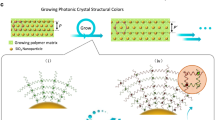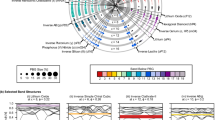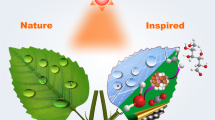Abstract
Biomimetics is the extraction of good design from nature. One approach to optical biomimetics focuses on the use of conventional engineering methods to make direct analogues of the reflectors and anti-reflectors found in nature. However, recent collaborations between biologists, physicists, engineers, chemists and materials scientists have ventured beyond experiments that merely mimic what happens in nature, leading to a thriving new area of research involving biomimetics through cell culture. In this new approach, the nanoengineering efficiency of living cells is harnessed and natural organisms such as diatoms and viruses are used to make nanostructures that could have commercial applications.
This is a preview of subscription content, access via your institution
Access options
Subscribe to this journal
Receive 12 print issues and online access
$259.00 per year
only $21.58 per issue
Buy this article
- Purchase on Springer Link
- Instant access to full article PDF
Prices may be subject to local taxes which are calculated during checkout






Similar content being viewed by others
References
Parker, A. R. 515 million years of structural colour. J. Opt. A 2, R15–28 (2000).
Parker, A. R., McPhedran, R. C., McKenzie, D. R., Botten, L. C. & Nicorovici, N. A. P. Aphrodite's iridescence. Nature 409, 36–37 (2001).
Gordon R. & Parkinson, J. Potential roles for diatomists in nanotechnology. J. Nanosci. Nanotech. 5, 51—56 (2005).
Miller, W. H., Moller, A. R. & Bernhard, C. G. in The Functional Organisation of the Compound Eye (ed. Bernhard C. G.). 21–33 (Pergamon Press, Oxford, 1966).
Yoshida, A., Motoyama, M., Kosaku, A. & Miyamoto, K. Antireflective nanoprotuberance array in the transparent wing of a hawkmoth Cephanodes hylas. Zool. Sci. 14, 737–741 (1997).
Gale, M. Diffraction, beauty and commerce. Phys. World 2, 24–28 (October, 1989).
Boden, S. A. & Bagnall, D. M. in Proc. 4th World Conference on Photovoltaic Energy Conversion, Hawaii 1358–1361 (IEEE, 2006).
Parker, A. R., Hegedus, Z. & Watts, R. A. Solar-absorber type antireflector on the eye of an Eocene fly (45Ma) Proc. R. Soc. Lond. B 265, 811–815 (1998).
Beale, B. Fly eye on the prize. The Bulletin 46–48 (25 May 1999).
Berthier et al. Anticounterfeiting using biomimetic polarization effects. Appl. Phys. A 86, 123 (2007).
Vigneron, J. P. et al. Spectral filtering of visible light by the cuticle of metallic woodboring beetles and microfabrication of a matching bioinspired material. Phys. Rev. E 73, 041905 (2006).
López, C. Three-dimensional photonic band-gap materials: semiconductors for light J. Opt. A 8, R1–14 (2006).
Cohen, R. E., Zhai, L., Nolte, A. & Rubner, M. F. pH gated porosity transitions of polyelectrolyte multilayers in confined geometries and their applications as tunable Bragg reflectors. Macromolecules 37, 6113 (2004).
Ghiradella, H. Structure and development of iridescent butterfly scales: lattices and laminae. J. Morph. 202, 69–88 (1989).
Vukusic P., Sambles J. R., Lawrence C. R. & Wootton, R. J. Structural colour: Now you see it — now you don't. Nature 410, 36 (2001).
Berthier, S. Iridescence: The Physical Colors of Insects (Springer, New York, 2006).
DeSilva, L. et al. Natural and nanoengineered chiral reflectors: structural colour of manuka beetles and titania coatings. Electromagnetics 25, 391–408 (2005).
Kinoshita, S., Yoshioka, S., Fujii, Y. & Okamoto, N. Photophysics of structural color in the Morpho butterflies. Forma 17, 103–121 (2002).
Watanabe, K., Hoshino, T., Kanda, K., Haruyama, Y. & Matsui, S. Brilliant blue observation from a Morpho-butterfly-scale quasi-structure. Jpn. J. Appl. Phys. 44, L48–L50 (2005).
Zhang, W. et al. Biomimetic zinc oxide replica with structural color using butterfly (Ideopsis similis) wings as templates. Bioinspir. Biomim. (submitted).
Potyrailo, R. A. et al. Morpho butterfly wing scales demonstrate highly selective vapour response. Nature Photonics 1, 123–128 (2007).
Fuhrmann, T., Lanwehr, S., El Rharbi-Kucki, M. & Sumper, M. Diatoms as living photonic crystals. Appl. Phys. B 78, 257–260 (2004).
Lehmann, V. On the origin of electrochemical oscillations at silicon electrodes. J. Electrochem. Soc. 143, 1313 (1993).
Rosi, N. L., Thaxton, C. S. & Mirkin, C. A. Control of nanoparticle assembly by using DNA-modified diatom templates. Angew. Chem. Int. Edn 43, 5500–5503 (2004).
Cullis, A. G., Canham, L. T. & Calcott, P. D. J. The structural and luminescence properties of porous silicon. J. Appl. Phys. 82, 909–965 (1997).
De Stefano, L., Rendina, I., De Stefano, M., Bismuto, A. & Maddalena, P. Marine diatoms as optical chemical sensors. Appl. Phys. Lett. 87, 233902 (2005).
Sandhage, K. H. et al. Novel, bioclastic route to self-assembled, 3D, chemically tailored meso/nanostructures: Shape-preserving reactive conversion of biosilica (diatom) microshells. Adv. Mater. 14, 429–433 (2002).
Bao, Z. Chemical reduction of three-dimensional silica micro-assemblies into microporous silicon replicas Nature 446, 172—175 (2007).
Rorrer, G. L. et al. Biosynthesis of silicon-germanium oxide nanocomposites by the marine diatom Nitzschia frustulum. J. Nanosci. Nanotechnol. 5, 41–49 (2004).
Hildebrand, M. & Palenik, B. Investigation into the Optical Properties of Nanostructured Silica from Diatoms. Grant report (2003); www.stormingmedia.co.uk
Quintero-Torres, R., Aragon, J. L., Torres, M., Estrada, M. & Gros, L. Strong far field coherent scattering of UV radiation by holococcolithophores. Phys. Rev.E 74 (2006).
Juhl, S. B. et al. Assembly of Wisean Iridovirus: Viruses for photonic crystals. Adv. Funct. Mater. 16, 1086–1094 (2002).
Radloff, C., Vaia, R. A., Brunton, J., Bouwer, G. T. & Ward, V. K. Metal nanoshell assembly on a virus bioscaffold. Nano Lett. 5, 1187–1191 (2005).
Giraud-Guille, M. M., Besseau, L. & Martin, R. Liquid crystalline assemblies of collagen in bone and in vitro systems. J. Biomech. 36, 1571–1579 (2003).
Parker, A. R., Welch, V. L., Driver, D. & Martini, N. An opal analogue discovered in a weevil. Nature 426, 786–787 (2003).
Murray, S. B. & Neville, A. C. The role of pH, temperature and nucleation in the formation of cholesteric liquid crystal spherulties from chitin and chitosan. Int. J. Biol. Macromol. 22, 137 (1998).
Schmid, A. M. M. Aspects of morphogenesis and function of diatom cell walls with implications for taxonomy. Protoplasma 181, 43–60 (1994).
Smith, M. A. The effect of heavy metals on the cytoplasmic fine structure of Skeletonema costatum (Bacillariophyta). Protoplasma 116, 14–23 (1983).
Saboski, E. Effects of mercury and tin on frustular ultrastructure of the marine diatom Nitzschia liebethrutti. Water Air Soil Poll. 8, 461–466 (1977).
Corstjens, P. L. A. M. & Gonzales, E. L. Effects of nitrogen and phosphorus availability on the expression of the coccolith-vesicle v-ATPase (subunit C) of Pleurochrysis (Haptophyta). J. Phycol. 40, 82–87 (2004).
Klaveness D. & Paasche E. in Biochemistry and Physiology of Protozoa 2nd edn, Vol. 1 (eds Hutner, S. H. & Levandowsky, M.) (Academic Press, New York, 1979).
Klaveness, D. & Guillard, R. R. L. The requirement for silicon in Synura petersenii (Chrysophyceae). J. Phycol. 11, 349–355 (1975).
Overton, J. Microtubules and microfibrils in morphogenesis of the scale cells of Ephestia kuhniella. J. Cell Biol. 29, 293–305 (1966).
Parker, A. R. Conservative photonic crystals imply indirect transcription from genotype to phenotype. Rec. Res. Develop. Entomol. 5, 1–10 (2006).
Bath, J. & Turberfield. A. J. DNA nanomachines Nature. Nanotech. 2, 275–284 (2007).
Parker, G. J. et al. Highly engineered mesoporous structures for optical processing. Phil. Trans. R. Soc. Lond. A 364, 189–199 (2006).
Threadgold, L. T. The Ultrastructure of the Animal Cell (Pergamon Press, Oxford, 1967).
Acknowledgements
This work was funded by the Royal Society (University Research Fellowship), the Australian Research Council, Framework 6 of the European Union, and RCUK (Basic Technology Grant).
Author information
Authors and Affiliations
Ethics declarations
Competing interests
The authors declare no competing financial interests.
Rights and permissions
About this article
Cite this article
Parker, A., Townley, H. Biomimetics of photonic nanostructures. Nature Nanotech 2, 347–353 (2007). https://doi.org/10.1038/nnano.2007.152
Published:
Issue Date:
DOI: https://doi.org/10.1038/nnano.2007.152
This article is cited by
-
The colourful optical appearance of centric diatom fossil frustules with diagenetic nanocrystalline calcite fill
Facies (2024)
-
Bioinspired chiral inorganic nanomaterials
Nature Reviews Bioengineering (2023)
-
Recent progress of dielectric polymer composites for bionics
Science China Materials (2023)
-
Metal deposition and shape reproduction at biological temperatures on cell-level samples
Scientific Reports (2022)
-
Freeze-derived heterogeneous structural color films
Nature Communications (2022)



